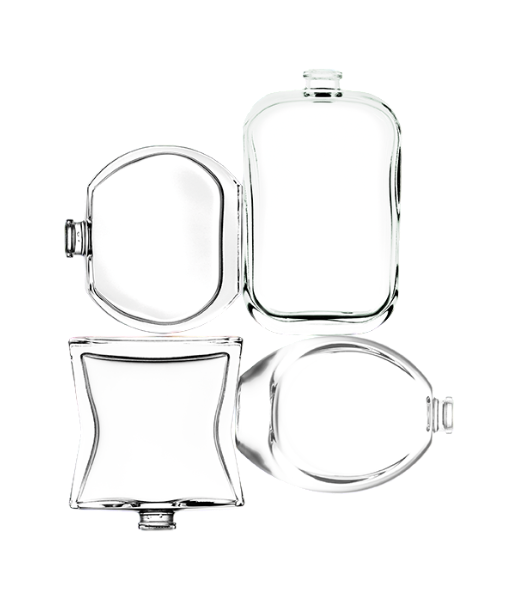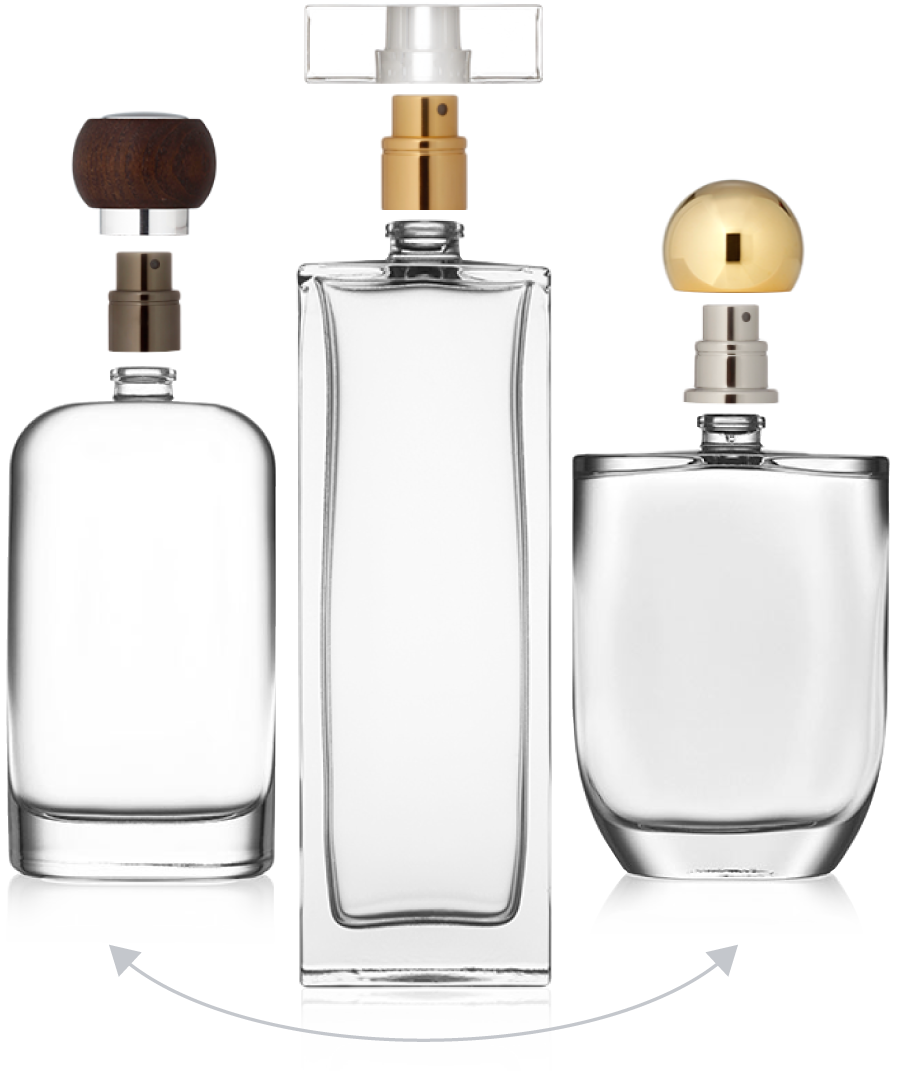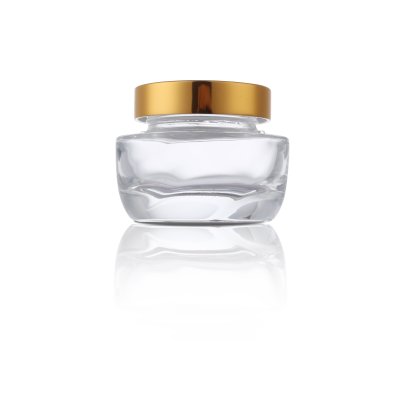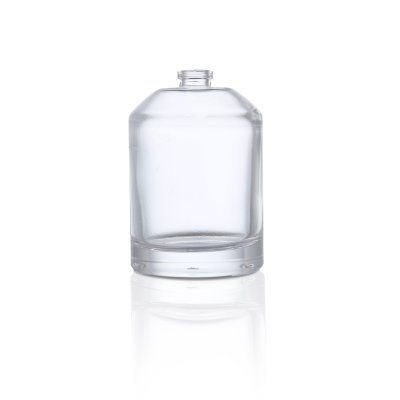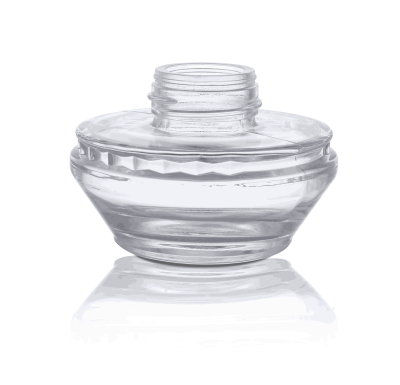Cosmetics Packaging Knowledge - Glass Bottles
Glass bottles are typically formed using the blow-blow method or the press-blow method. The blow-blow method is suitable for narrow-mouth bottles, such as those for lotions and liquids, while the press-blow method is generally used for wide-mouth bottles, like those for creams.
The process of treating the surface or inner wall of a glass bottle is called glass bottle deep processing. This includes processes such as frosting, silk screening, hot stamping, spraying, electroplating, and polishing, which give the glass bottle different surface effects.
Frosting Process
The principle of chemical frosting is:
Chemical frosting glass is essentially a rough acid-etched glass, similar to chemical etching and chemical polishing, which both utilize the chemical corrosion effect of acid on the glass surface.
People can apply frosting to the entire outer surface of glass products or just part of it to create patterns. The frosting process for creating patterns is commonly referred to as rough surface etching.
Chemical Polishing
This involves dissolving and washing away certain insoluble reaction products that adhere to the glass surface after chemical corrosion. The chemical polishing process always erodes the entire surface uniformly, resulting in a transparent and smooth surface.
Chemical Frosting
It leaves insoluble reaction products adhering to the glass surface, which accumulate over time to form granular crystals (fluorosilicate crystals) that firmly attach to the surface. This obstructs further acid corrosion, leading to non-uniform erosion and a half-transparent rough surface. The rough surface scatters incident light, giving it a translucent appearance with a blurry feel, hence the term "frosted."
Frosting Materials
There are primarily three types of materials used for chemical frosting: hydrofluoric acid, frosting paste, and frosting powder.
Hydrofluoric acid can produce good results if properly proportioned and requires less time than frosting paste or powder. However, it is not suitable for mass production, especially during hot weather, due to its instability and potential to cause environmental pollution. Hydrofluoric acid is highly hazardous to humans, capable of corroding skin and bones, and is gradually being phased out.
Frosting paste is often used for localized frosting on glass products and is relatively convenient to use. However, it is not ideal for large areas of glass, as it can result in uneven frosting. Frosting paste is commonly used in screen printing.
Frosting powder is slightly more complex to use, as it needs to be mixed into a solution. Nevertheless, it can be used for almost all glass products. It can frost glass cups, bottles, and lamps by immersing them in the solution, and it can also frost flat glass and sliding door glass that cannot be immersed directly.
The main chemical components of frosting powder include fluorides, ammonium sulfate, barium sulfate, potassium sulfate, and other additives.
Frosting Methods
Immersion Method: Soaking the glass product in the frosting solution for a certain period.
Spray Method: Spraying the frosting solution onto the glass surface.
Coating Method: Applying frosting paste to the glass product's surface.
Frosting Procedure
Acid Washing (Cleaning the glass surface)
Frosting (Approximately 45 seconds)
Acid Washing (Cleaning off the frosting solution)
Water Washing (Removing all the frosting solution)
Drying (Using air or other methods to dry the frosted glass)
Comparison Between Frosted Glass and Sandblasted GlassSandblasted Glass:
Sandblasted glass is produced by blasting glass particles at high speed onto the glass surface, creating a micro-rough texture that gives a hazy effect and refracts light. The finer the glass particles, the more detailed and three-dimensional the effect. [Usage: The particles in sandblasted glass are large, prone to dust accumulation, and difficult to clean. It is an early glass treatment technique, commonly used in construction, decoration, bathroom windows, etc.] Compared to frosting, sandblasted glass products have a coarser surface texture, higher breakage rates, and more dust contamination. The process difficulty is average.
Frosted Glass:Ordinary glass bottles become frosted glass bottles after being treated with frosting powder. The process involves immersing the bottles in a chemical solution to corrode the surface, allowing for silk screening and artwork on the glass surface. Frosted glass has a finer texture, is durable and easy to clean, and is more expensive and costly to produce than sandblasted glass. If further polished, the glass feels softer, has no fingerprints, and better light transmission, also known as jade frosted glass.
Matte Glass:Also known as frosted glass bottles or dark glass bottles, matte glass is made by mechanically sandblasting, hand grinding, or using hydrofluoric acid to create a uniform surface on ordinary flat glass. Its rough surface causes light to scatter diffusely, making it translucent without being transparent. Matte glass bottles can soften light and make it less harsh. Thin glass is not suitable for frosting.
Common Frosting Issues
Uneven Frosting:
Surface reasons include varying degrees of corrosion and uneven thickness of the frost layer. Behind this is the uneven distribution of the frosting solution. The solution involves adding hydrochloric acid and hydrogen fluoride to accelerate the maturation and dissolution of the frosting solution. Adding old frosting solution can help balance the intensity.
Translucency:
Light: Hydrofluoric acid 7%, Hydrochloric acid 5%, Water 88%
Heavy: Hydrofluoric acid 12%, Hydrochloric acid 5%, Water 85%, followed by an additional rinse.
Can be caused by foreign objects on the bottle body, the frosting solution itself, or acid washing. Oil stains on the bottle body appear as regular semi-translucent areas. During the frosting process, areas without oil stains react with the frosting solution first, while areas with oil stains are first decomposed by hydrogen fluoride before reacting with the frosting solution. The difference in reaction times leads to the appearance of regular semi-translucent areas. The solution involves acid washing. Depending on the severity of the oil stain, different acid washing ratios are used:
Silk Screening:
Commonly used silk screening methods are high-temperature and low-temperature silk screening.
Low-temperature silk screening uses oil-based ink that is baked at around 150°C after printing. Some silk screening does not require baking and dries naturally. Advantages include a wide range of colors, stable ink, and minimal color variation. It is suitable for complex designs, such as halftones and fine text. Disadvantages include weak adhesion of the ink, which can easily smear or chip.
High-temperature silk screening uses powdered ink that is baked at 550-700°C after printing. Advantages include good wear resistance, colorfastness, strong adhesion, vibrant colors, and bright hues. Disadvantages include limited color options, potential for color variation, and difficulty in reproducing certain colors like purple, as well as fine text and lines.
Hot Stamping:
Hot stamping is performed on wet low-temperature silk-screened ink using hot stamping paper at 200°C. It relies on pressure and temperature to transfer metal foil or pigment foil onto the surface of the printed item according to the pattern on the stamping plate. For high-end products, customers may opt for hot stamping of trademarks or logos. Typically, gold and silver are used, and other colors can be produced, but the raw materials do not allow for custom coloring.
Spraying:
Spraying involves applying a uniform layer of water-based paint to the product surface using an air gun. After spraying, the product goes through leveling, preheating, curing, and cooling, which solidifies the coating and decorates and protects the glass bottle. Various spraying effects enhance the product's appearance.
A layer of organic coating (glass coating combined with specific colors and additives) is applied to the glass bottle surface, achieving a rich color palette and various effects such as glossy, matte, pearlescent, transparent, and gradient.
Spray Process:
Bottle Loading → Cleaning → Flame Treatment → Static Dust Removal → Spraying → Preheating → Curing → Cooling → Unloading → Packaging
Electroplating:
The two common electroplating processes are water electroplating and vacuum ion plating, with vacuum ion plating being the most commonly used.
Vacuum plating is a physical deposition phenomenon. In a vacuum state, argon gas is introduced, which collides with the target material, causing it to separate into molecules that are adsorbed onto the conductive product to form a uniform and smooth surface layer.
Vacuum plating is mainly divided into evaporation and sputtering.
Electroplating is done in an electroplating pool, while sputtering occurs at high voltage and high temperatures, as seen with aluminum deposition in CDs.
Vacuum plating can produce a black finish with excellent gloss that cannot be achieved with conventional electroplating.
PC materials can withstand temperatures up to 130°C, and only "vacuum plating + UV oil curing" can meet this requirement. Regular water electroplating cannot be applied to PC materials.
Vacuum plating includes vacuum evaporation, vacuum sputtering, and vacuum ion plating.
Vacuum ion plating, also known as vacuum coating, is a popular method that produces a strong metallic appearance and high brightness at a lower cost and with less environmental impact.
Vacuum Ion Plating Technology:
The technology works by generating an arc in a vacuum chamber on the surface of the cathode material, causing the cathode material to evaporate and form atoms and ions. Under the influence of an electric field, atomic and ionic beams bombard the surface of the anode workpiece at high speeds. Meanwhile, reaction gases are introduced into the vacuum chamber, forming a high-performance coating on the workpiece surface. Cathode materials (also known as targets) are typically titanium, chromium, or zirconium, and common reaction gases are nitrogen and hydrocarbons. The coatings obtained include TiN, CrN, TiC, and ZrN.
Advantages of Vacuum Ion Plating:
(1) High-hardness coatings with low friction coefficients and high wear resistance.
(2) Chemically stable coatings with good high-temperature oxidation resistance and corrosion resistance.
(3) Attractive coatings with a golden hue resembling 18K gold and other colored films.
(4) Strong adhesion between the coating and the substrate, making the coating less likely to peel off compared to traditional magnetron sputtering and vacuum evaporation coatings.
(5) Environmentally friendly production process with fast coating formation, energy and water savings.
Vacuum Coating:
Vacuum coating refers to a method of heating metals or non-metals under high vacuum conditions, causing them to evaporate and condense on the surface of the substrate (metal, semiconductor, or insulator) to form a film. Examples include vacuum aluminum plating and vacuum chromium plating.
Vacuum Electroplating:
Vacuum electroplating includes general vacuum electroplating and UV vacuum electroplating. Special processes include evaporation, sputtering, and gun coloring.
Vacuum Evaporation:
Vacuum evaporation, or simply evaporation, involves evaporating the coating material (also known as the film material) under vacuum conditions using a heating method (such as tungsten wire) and allowing the evaporated particles to fly to the substrate surface where they condense into a film. Evaporation is an early and widely used vapor deposition technique, offering simple film formation methods, high film purity and density, and unique film structures and properties.

